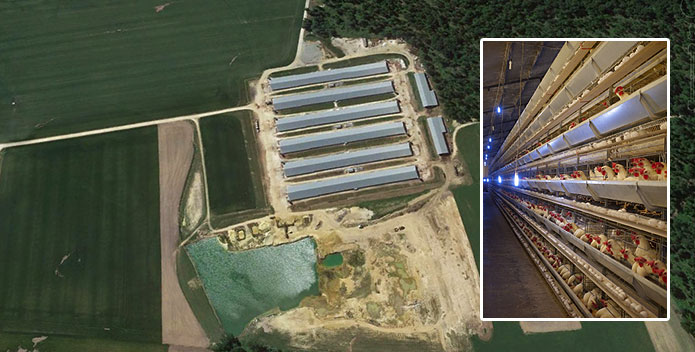Reducing Phosphorus Pollution in Maryland
Phosphorus is one of the three major pollutants affecting the health of the Chesapeake Bay. Excess phosphorus contributes to dead zones—areas with low levels of oxygen where marine life cannot live—in creeks, rivers, and the Chesapeake Bay.
One of the largest sources of phosphorus is manure. While Maryland is on track to meet its phosphorus reduction goals statewide, soil phosphorus saturation and the potential for phosphorus runoff is not evenly distributed.
Click >> to toggle legend on and off
The Maryland Department of Agriculture now confirms, with soil tests from all over the state, that only 18 percent of Maryland farm field acreage is polluting rivers and streams and the Chesapeake Bay due to excessive levels of phosphorus from manure. This problem is especially troubling on the Eastern Shore, where phosphorus-rich poultry litter from the area’s growing poultry industry is extensively used as fertilizer. The Eastern Shore's Choptank River is the only major river in Maryland where phosphorus pollution is on the rise. This is linked to a legacy of phosphorus over-application and the fast drainage of agricultural fields to tidal waters through a network of drainage ditches.
As part of the Chesapeake Clean Water Blueprint, Maryland is required to reduce phosphorus pollution 48 percent by 2025. The state's Watershed Implementation Plan (WIP) includes methods for achieving that goal. One of the most important methods is reducing the amount of phosphorous applied to fields that have the highest risk of phosphorus runoff, which pollutes local waters, especially on the Eastern Shore. Enter the Phosphorus Management Tool (PMT), a science-based method of identifying the fields that contain the most phosphorous and have the highest risk of phosphorus runoff.
How the Phosphorus Management Tool Works
Phosphorus, like nitrogen and other nutrients, is vital to crops. However, like nitrogen, when there is more phosphorus in the soil than the crops can take up, the excess runs off the field and into nearby streams. Soil can be tested to determine how much phosphorus it contains, and is then classified as having "low," "medium," "optimum," or "excessive" amounts. In addition to how much excess phosphorus is in the soil, the Phosphorus Management Tool (PMT) takes into consideration the slope of the land, type of soil, and proximity of waters—all factors that affect the likelihood that excess phosphorus will find its way into local waterways.
Adopted in 2015, the PMT identifies hot spots where the soil is saturated with phosphorus and where other factors, such as networks of drainage ditches, signify a high risk of polluted runoff. Future applications of manure will be limited in these areas and farmers will need to implement techniques that remove some of the excess phosphorus or draw it down slowly. Examples of techniques include changing crops, managing soil pH or expanding the use of nitrogen-fixing cover crops that fertilize the soil without adding phosphorus.
The rule's restrictions are being phased in through 2022. Maryland's early phases of implementation have already limited phosphorus application on over 10,000 acres of the most highly saturated soils. The next phase will affect less than half that acreage, but before it is fully implemented, more than 150,0000 acres will be subject to the new regime.
Through our long years of cooperative problem solving with farmers, our devotion to supporting scientifically sound policy changes, and our own experience running Clagett Farm, CBF is participating in several forums to assist with PMT implementation. These include conducting important field trials that will reduce the need for phosphorus while increasing soil health. Some individual farmers may shoulder an additional financial burden under the PMT. We continue to support cost-share programs to mitigate these costs for affected farmers. We also believe that, in addition, big agricultural corporations should help pay for the cost of cleaning up the manure their chickens produce. One such promising program is the Delmarva Land and Litter Challenge, which brings together industry representatives, farmers, state agencies, and environmental groups to collaborate on streamlining manure transportation programs and development of new technologies in Delaware, Maryland, Virginia, and even Pennsylvania, which accepts much of the excess manure for mushroom growing.
The Economics of the PMT
Reducing pollution from agriculture is one of the most cost-effective ways—acre for acre, and pound for pound—to restore local water quality and the Bay. It's a much better "bang for the buck" than other, more costly solutions like wastewater treatment plant upgrades, which have already been done, supported by tax dollars.
Programs like the PMT that reduce pollution are also estimated to provide additional economic benefits in Maryland of $4.6 billion per year if the Clean Water Blueprint is fully implemented. Thanks to improvements in soil health and productivity, benefits from Maryland's agricultural lands will increase by more than $73 million per year.
Additionally, the PMT presents an opportunity for economic growth and innovation through the potential for new technologies to process, transport, and export excess phosphorus. While restoring water quality, these new regulations also provide a reliable supply of phosphorus for new companies seeking to develop methods to make phosphorus more readily available and transportable to American and international markets where phosphorus is a limited commodity. Some of these new technologies also produce heat, electricity, and useful soil amendments as by-products.
The Chesapeake Clean Water Blueprint now incorporates the PMT in Maryland. Neighboring states on the Delmarva peninsula are now considering reciprocal manure transport programs and treatment technology facilities to maximize efficiency across the region and at the scale of the industry.
Staying the course of PMT implementation according to its phase-in schedule will be necessary to bring Maryland’s agriculture sector in line with phosphorus reduction goals and prevent water quality hot spots in places like the Lower Eastern Shore, even as this important industry maintains some capacity for expansion. Ultimately, the precious natural resource of phosphorus will need to be distributed where needed by crops without sacrificing the Bay's water quality.



